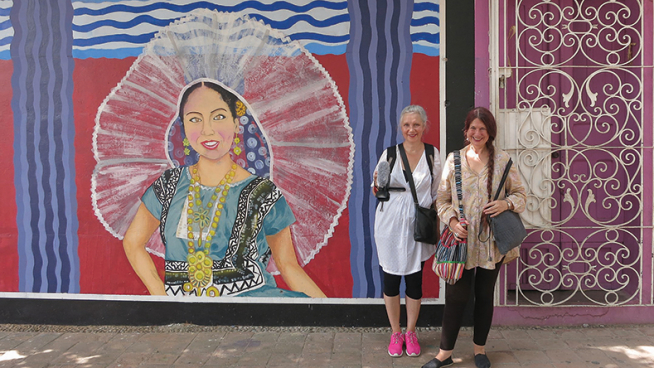Mexico’s Day of the Dead at the ROM

Chloe Sayer, guest curator of ¡Viva México! Clothing & Culture and ROM Research Associate, is back in Toronto for the ROM’s celebration of Day of the Dead on October 30, one of Mexico’s most important annual festivals.
But Chloe hasn’t returned alone. She’s joined by Arturo Estrada, a master-dyer and master-weaver of silk rebozos (women’s rectangular shawls), and Sergio Hernández, a paper artist. Both will be demonstrating their art until October 30 in the Roloff Beny Gallery on Level 4.
Sascha Priewe, Managing Director, ROM (ROM): Great to have you back in Toronto to celebrate Day of the Dead at the ROM, about which you will be giving a lecture. The Day of the Dead is an important annual festival in Mexico. What do the Mexicans celebrate?
Chloe Sayer (CS): I am looking forward to talking about the Days of the Dead. This festival is so central to Mexican culture, yet it is often misunderstood outside Mexico. There is the celebration itself, and then there are the artworks in clay, paper, wood and so on that that evoke and represent Death.
ROM: How is it celebrated?
CS: The Days of the Dead are celebrated on 1 and 2 November, All Saints and All Souls, but the festival also incorporates beliefs and practices from pre-Christian times. Anthropologists argue about the extent of the fusion. Today, throughout central and southern Mexico, families set out offerings in the home to welcome back the souls of the departed. It is thought that they have divine permission to return to Earth for this brief period, and the living are able to show those they have lost that they love and remember them.
ROM: What are these offerings?
CS: Offerings include flowers, incense, candles, and also food. Children are offered sweet things: hot chocolate, sweet breads, sugar figures. Adults are offered spicy foods, and alcohol. The idea is to offer the things that the deceased liked in life. The souls take the essence of the food, not the food itself.
ROM: What can people outside Mexico learn form this festival?
CS: As I said, it is often misunderstood and confused with Halloween. People in Mexico tell me that they feel tranquil and immensely comforted after this visitation by their loved ones. You don’t ‘see’ or ‘hear’ the dead, there is nothing ‘spooky’ about it. After the more intimate reunion in the home, when the dead visit the offerings, families go to the cemetery on the night of the 1st or on the morning of the 2nd of November. Importantly, this is a collective event that the community shares. People in the UK (where I live) can feel very isolated after the death of someone they love.
ROM: You mentioned the other aspect of the festival, the folk art side?
CS: That is also crucially important. Popular artists represent death using every sort of material you can imagine – sugar, painted tin, clay, horn, paper… The ancient Mexicans were not shy about representing death, and today there is a rich tradition: skulls are shown, but with flowers in the eye sockets; skeletons perform everyday activities. You can buy skeleton shoe-cleaners, bridal couples and secretaries. This is a modern take on the mediaeval ‘dance of death’.
ROM: How popular is the Day of the Dead outside of Mexico?
CS: The folk art – the skulls and skeletons -- are extremely popular outside Mexico. But, as every Mexican would tell you, death is treated with humour, but also with affection and – above all – with respect. No one laughs AT death!
ROM: Sergio Hernández is at the ROM especially for Day of the Dead. What is he making?
CS: In his home town, Metepec in the State of Mexico, Sergio makes papel picado -- he uses colourful sheets of tissue paper and a series of metal chisels to hammer through his designs. These paper banners are displayed on home-altars to welcome the souls. Sergio is making an altar in the Roloff Beny Gallery and it will be very splendid. He will cover the wall with paper banners -- his designs show flowers but also death imagery. He will also set out the necessary elements: elaborate ceramic incense burners and angels, paper flowers, dishes of food -- replicated in clay and paper, because we are in a museum -- a glass of water, and a dish of salt. It will be beautiful!
ROM: Thank you, Chloe. It is exciting to you have you back together with Sergio and Arturo.
“Celebrating Mexico’s Day of the Dead” with Chloe Sayer is at 6pm on October 30 in the Royal Ontario Museum, Signy and Cléophée Eaton Theatre. The lecture is free. RSVP required. Doors open at 5:30pm.
The talk also launches Mexico: Clothing & Culture, the book accompanying the exhibition ¡Viva México! Clothing & Culture. The book will be on sale at the event on October 30.
Join us for Friday Night Live: Day of the Dead after the talk. FNL tickets will be available for sale after the talk.
The exhibition ¡Viva México! Clothing & Culture is on view in the Patricia Harris Gallery of Textiles & Costumes until May 23, 2016. #VIVAMex
